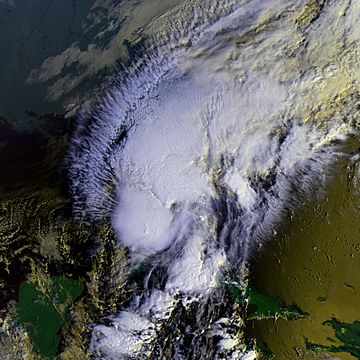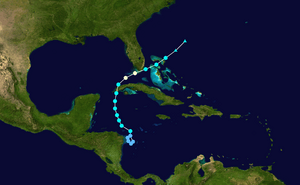Hurricane Floyd (1987) facts for kids
| Category 1 hurricane (SSHWS/NWS) | |

Satellite image of Hurricane Floyd approaching Florida
|
|
| Formed | October 9, 1987 |
|---|---|
| Dissipated | October 13, 1987 |
| Highest winds | 1-minute sustained: 75 mph (120 km/h) |
| Lowest pressure | 993 mbar (hPa); 29.32 inHg |
| Fatalities | 1 reported |
| Damage | $500,000 (1987 USD) |
| Areas affected | Cuba, Florida and The Bahamas |
| Part of the 1987 Atlantic hurricane season | |
Hurricane Floyd was a powerful storm that hit the United States in 1987. It was the only hurricane to reach the U.S. that year. Floyd started as a storm on October 9, 1987, near Nicaragua. It then grew stronger and moved north.
The storm crossed western Cuba as it continued its path. A cold front (a boundary between cold and warm air) made Floyd suddenly turn northeast. On October 12, it became a hurricane near the Florida Keys. Floyd moved through southern Florida, causing some damage. It also created two tornadoes. The hurricane caused dangerous rip tides, which led to one death in southern Texas. Floyd was a hurricane for only 12 hours. It then weakened because of the cold front. The storm passed through The Bahamas before it changed into a different type of storm. It finally disappeared on October 14.
Contents
How Hurricane Floyd Formed and Moved
Hurricane Floyd began as a low-pressure area. This happened in the Gulf of Honduras on October 5. Over the next few days, it slowly moved east and then south. By October 9, special planes called Hurricane Hunters flew into the storm. They confirmed that it had an organized circulation. This meant it had become the thirteenth tropical depression of the year.
The depression first moved south. Then, it turned north and later northwest. This change happened because of a weather pattern called a ridge to its east. With another weather pattern called an anticyclone above it, the storm slowly got stronger. On October 10, it became Tropical Storm Floyd.
Floyd's Journey and Changes
After becoming a tropical storm, Floyd sped up its movement north. It was in the western Caribbean Sea. This quick movement was due to a cold front coming closer. The storm kept getting stronger. Early on October 12, Floyd moved over the far western part of Cuba.
At first, experts thought Floyd would hit Florida between Naples and Fort Myers, Florida. But the storm suddenly turned sharply northeast. It moved into the southeastern Gulf of Mexico. The Hurricane Hunters reported that Floyd briefly became a hurricane on October 12. Around the same time, the nearby cold front created a low-pressure area. This cut off the hurricane's "inflow," which is the warm, moist air it needs to stay strong.
While moving through the Florida Keys, Floyd became the only hurricane to affect the United States that year. However, its strong thunderstorms were quickly fading. This was because of the cold front. Soon after, Floyd weakened back to a tropical storm. It became very hard to see its center on satellite images. But ground reports showed it passed just south of Miami. The storm then changed into an "extratropical" storm. This happened as it weakened over The Bahamas. By late on October 18, Floyd was no longer a tropical cyclone. Its circulation disappeared within the cold front the next day.
Getting Ready for the Storm
When Floyd first became a tropical storm, warnings were sent out. These warnings went to the Swan Islands and Grand Cayman. Soon after, a tropical storm warning and hurricane watch were issued. These were for the northeast Yucatán Peninsula. The storm brought heavy rain to the coast there.
Warnings were also sent to Cuba, west of Havana. To get ready, Cuban officials in Pinar del Río Province moved 100,000 people to safety. They also moved 40,000 cattle. International flights were stopped for a day while Floyd passed. Floyd went over Western Cuba as a tropical storm. Luckily, it did not cause serious damage or deaths in the country.
What Happened in Florida
When Floyd was over Cuba, the National Hurricane Center issued a hurricane warning for the Florida Keys. This warning also covered the southwest Florida coast up to Venice. It was the first warning for Florida related to the storm. Experts expected Floyd to become a hurricane quickly.
A tropical storm watch, then a warning, was also issued for eastern Florida. But the storm's path shifted more to the east. So, a hurricane warning was then issued for southeastern Florida. It was also issued for the northwestern Bahamas.
Officials in southern Florida closed schools because of the storm. Some flights were canceled at Miami International Airport. About 100 fighter jets were moved from Homestead Air Force Base to safer places. The American Red Cross opened 55 shelters in 10 Florida counties. About 2,000 people stayed in these shelters at one point. Many were in Lee County. People in the storm's path got ready by buying supplies. They also filled their car gas tanks and secured loose items outside their homes.
After the Storm: Damage and Effects
Floyd was the first named storm to hit southern Florida in two years. The last one was Hurricane Bob in 1985. As Floyd passed south of Florida, its strongest winds were over the water. They were away from land. The strongest wind in the Florida Keys was 59 miles per hour (94 km/h) at Duck Key. But wind gusts were even stronger. An Air Force station on Cudjoe Key reported an unofficial gust of 92 mph (152 km/h).
Rainfall directly from Floyd's rainbands was low, about 1 inch (25 mm). However, the hurricane and the cold front working together caused much heavier rain. This rain reached as far north as Daytona. The most rain fell in Fort Pierce, with 10.07 inches (256 mm). Floyd also created a waterspout that moved onto land in Rock Harbor. It damaged some boats and homes. The hurricane caused dangerous rip tides. These rip tides reached as far west as the Texas coast. One person died along South Padre Island because of them.
Across southern Florida, the hurricane caused minor damage. This damage was estimated at about $500,000 in 1987. It was mostly due to trees falling and power lines breaking. There was also minor damage to crops in Dade County. The heavy rain flooded roads in southern Florida. This caused several cars to break down on the Florida Turnpike. After affecting Florida, Floyd caused minor wind damage in The Bahamas. The highest reported wind gust there was 48 miles per hour (77 km/h). This was in Freeport, Grand Bahama. Freeport International Airport reported steady winds of 40 miles per hour (64 km/h) from the storm's leftover parts.



